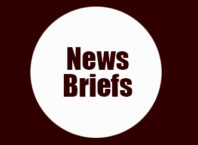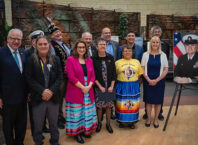FIFTH ANNUAL OJIBWE IMMERSION ACADEMY
ANNOUNCED
MINNEAPOLIS – Ojibwemotaadidaa Omaa
Gidakiiminaang and Fond du Lac Tribal and Community College are
pleased to announce the fifth annual Ojibwe Immersion Academy to be
held June 14-July 3, 2015 at the Fond du Lac Tribal & Community
College in Cloquet, Minn.
The Ojibwe Immersion Academy is a rare
opportunity for intermediate and advanced language learners to study
one-on-one and in small groups with Ojibwe elders and faculty
speakers for a three-week complete immersion experience.
For more information or another
application packet, email ojibwemotaadidaa@gmail.com
with subject "Application Request.” All applications are due
before 4 p.m. March 24.
NATIVE ORGANIZATION RECEIVES $250,000
FROM SMSC TO MEET CHALLENGES
RAPID CITY, S.D. – Rural America
Initiatives is $500,000 closer to attaining a new Head Start
building, thanks to a $250,000 matching grant from the Shakopee
Mdewakanton Sioux Community.
In December 2013 the SMSC committed
a quarter of a million dollar grant dependent on RAI raising matching
funds and in December 2014, after a $100,000 donation from an
anonymous donor, RAI met that goal.
“We will always be grateful
to the Shakopee Tribe. They recognized early on the benefit this
facility would be to our people and they stepped up to help. It was
their gift that raised awareness in our community, generated
additional support, and allowed us to launch our campaign,” said
Bruce Long Fox, Executive Director of Rural America Initiatives.
In
addition to an anonymous donor, the following companies are among the
individuals and businesses that helped RAI meet its matching goal:
Black Hills Corp/Black Hills Power; Jim Scull of J. Scull
Construction; First Interstate Bank; US Bank; SD Community
Foundation; Beverly M./Lloyd W. Paulson Charitable Gift Fund; and
Casey Peterson and Associates
Using these funds as momentum, RAI,
a long-standing nonprofit organization serving Native American
families in Rapid City, plans to raise an additional $6 million to
build a new Head Start/Community Center building. Its current
buildings, originally meant to be temporary, have exceeded their
intended lifespan by a dozen years and are fully depreciated. The new
building is expected to serve 150 children and their families each
year, helping children below poverty level gain the skills they need
to be ready to learn on par with their peers when they enter
kindergarten.
Rural America Initiatives seeks to create community
change by role modeling positive, healthy, alcohol and drug free
lifestyles incorporating Lakota/Dakota values. Family and children
taught by the organization will have a lasting impact on future
generations. RAI seeks to strengthen individuals, families and the
Native community in Rapid City.
RAI is the largest, non-profit,
continuously operating Native American organization in Rapid City.
Founded in 1986 to partner with Native American families to
strengthen the development of healthy, sober, self-sufficient
lifestyles, it has been the service provider for the most at-risk
Rapid City families for close to 30 years.
UM-MORRIS RECEIVES NSF FUNDING FOR
NATIVE STUDENTS
MORRIS, Minn. – The National Science
Foundation awarded $893,041 in funding for the University of
Minnesota, Morris Improving Undergraduate STEM Education program. The
goal of the project, under the direction of Professor of Geology Jim
Cotter, is to increase the number of Native American graduates in the
areas of environmental sciences and sustainability.
The five-year program, began in 2014.
It serves 30 student participants and eight undergraduate interns
each year, for a total of 190 students by its conclusion in 2019.
Program components include: early-encouragement outreach to
reservations; continuation of the Wind-STEP program for American
Indian high-school students; IUSE Environmental Science and
Sustainability summer program for tribal-college students; IUSE
Summer Internship Program with local business, and; IUSE Enrichment
Program to provide advice for the transition after college.
According to Cotter, complex
environmental challenges require interdisciplinary solutions. “It
is equally true,” he says, “that approaches to the environment
require a diversity of viewpoints.” He believes increasing the
number of Native American scientists in the environmental fields
through programs like UMM-IUSE will lead to broader perspective on
approaches to the environment.
“Education is the long-term solution
to complex environmental problems, and the goal of the UMM-IUSE
program is to develop model programs in undergraduate STEM
education,” he says. “This program will augment Morris’s
efforts to take a leadership role in environmental education and will
positively impact partnering communities.”
The UMM-IUSE program is only the
latest NSF-funded opportunity for Native American students at Morris.
For 10 years the foundation has provided funding for Research
Experience for Undergraduates and Science, Technology, Engineering,
and Mathematics Talent Expansion Program projects, led by Cotter, to
encourage the participation of American Indian students in the
sciences. NSF also recently funded the REU “Indigenous American to
Indigenous Borneo,” led by Michael Ceballos, assistant professor of
biology.
At Morris, Native students comprise 16
percent of the student body and have a six-year graduation rate of 61
percent, compared to the statewide average of 39. The campus also
hosts the highest percentage of American Indian students in the
University of Minnesota system.
The National Science Foundation IUSE
program invites proposals that address immediate challenges and
opportunities facing undergraduate STEM education as well as those
that anticipate new structures and functions of undergraduate
learning and teaching.
NCAI CONGRATULATES GOOGE ON RAISING
TRIBAL NATION VISIBILITY
WASHINGTON, D.C. – The National
Congress of American Indians announced the results of joint efforts
with Google to ensure better visibility for Indian reservations in
the United States on Google Maps. Over the past year, Google launched
several improvements for the way reservations appear on Google Maps,
including labeling reservations, highlighting reservation borders in
search results, and ensuring that their reservation dataset is as
comprehensive as possible. The most recent update was rolled out in
November to coincide with Native American Heritage Month.
In 2012, NCAI and the Google American
Indian Network co-hosted a summit at the Googleplex in Mountain View,
Calif. At the summit, tribal leaders underscored the role of tribal
nations as first American governments, explained the significance of
land to Native peoples, and urged Google to consider closer
partnerships with Native peoples as the first American innovators.
As a result of those discussions,
Google Maps now makes it easier than ever to search for federally
recognized tribal reservations. The project was led by the Google
American Indian Network (GAIN) and the Google Earth Outreach (GEO)
team in close collaboration with NCAI and the Tribal Technology
Taskforce. Including reservations on Google Maps is an important part
of creating a comprehensive map of the United States and the world.
Google and NCAI worked together to accurately represent reservation
labels, borders, and additional details in a way that was respectful
of Indigenous communities.
Welcoming the development, NCAI
President Brian Cladoosby released the following statement: “NCAI
congratulates Google on this important innovation to acknowledge the
place of tribal nations in the American family of governments.
America’s 566 federally recognized tribes are acknowledged
alongside foreign nations and state governments in the US
Constitution and they have jurisdiction over a land base of over 100
million acres. This land base is larger than all but three American
states.
Thanks to the partnership between NCAI
and the GAIN and GEO teams, the lands of America’s first
governments are now clearly highlighted on Google Maps. We look
forward to our ongoing partnership to improve the representation of
tribal lands on Google Maps.
This is a great step forward to
acknowledge the place of tribes in the past, present, and future of
the United States, but it is not the last. NCAI will continue to
build partnerships with tech companies like Google to ensure the
first American innovators remain on the front lines of 21st century
innovation."
SMSC OFFERS $55,000 GRANT TO TURNABOUT
GRANITE FALLS, Minn. – The Shakopee
Mdewakanton Sioux Community is offering Project Turnabout Addiction
Recovery Center’s capital expansion a $55,000 grant to be matched
with contributions from others.
“With its potential to turn into
$110,000, this gift is a great help in our Phase II and III capital
expansion,” Michael Schiks, Project Turnabout Executive
Director/CEO, said in a press release. “It helps us complete our
new 27-bed Women’s Unit and update the Central Medical area at our
Granite Falls campus. We look forward to inviting others to help us
realize the matching grant opportunity.”
Responding to a need for more
treatment beds, Project Turnabout focused throughout the past year on
expanding its capacity to serve individuals seeking help for chemical
dependency and problem gambling addictions. When complete, the Center
will have 33 more beds; bringing its capacity to 122 patients. As
many as 480 more people per year will receive treatment services than
the Center had been able to help in the past.
A new Family and Education Center and
administrative building were completed this past fall in Phase I of
the expansion.
Project Turnabout Addiction Recovery
Center, a nonprofit organization, is headquartered in Granite Falls.
Its interdisciplinary treatment program is nationally accredited
through the Commission on Accreditation of Rehabilitation Facilities
and is licensed by the Minnesota Departments of Health and Human
Services. Comprehensive care for individuals suffering from addictive
illness is offered in a variety of settings and locations including
inpatient/residential treatment, outpatient and transitional living
services. Services are provided in Granite Falls, Marshall, Redwood
Falls and Willmar.






